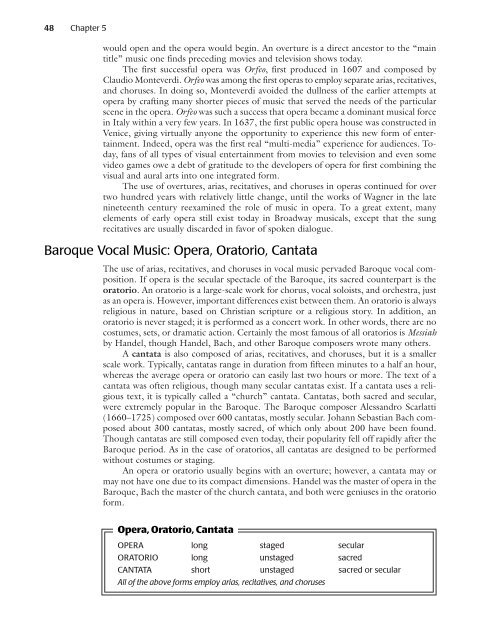Composer Profile - Activefolio
Composer Profile - Activefolio
Composer Profile - Activefolio
You also want an ePaper? Increase the reach of your titles
YUMPU automatically turns print PDFs into web optimized ePapers that Google loves.
48 Chapter 5<br />
would open and the opera would begin. An overture is a direct ancestor to the “main<br />
title” music one finds preceding movies and television shows today.<br />
The first successful opera was Orfeo, first produced in 1607 and composed by<br />
Claudio Monteverdi. Orfeo was among the first operas to employ separate arias, recitatives,<br />
and choruses. In doing so, Monteverdi avoided the dullness of the earlier attempts at<br />
opera by crafting many shorter pieces of music that served the needs of the particular<br />
scene in the opera. Orfeo was such a success that opera became a dominant musical force<br />
in Italy within a very few years. In 1637, the first public opera house was constructed in<br />
Venice, giving virtually anyone the opportunity to experience this new form of entertainment.<br />
Indeed, opera was the first real “multi-media” experience for audiences. Today,<br />
fans of all types of visual entertainment from movies to television and even some<br />
video games owe a debt of gratitude to the developers of opera for first combining the<br />
visual and aural arts into one integrated form.<br />
The use of overtures, arias, recitatives, and choruses in operas continued for over<br />
two hundred years with relatively little change, until the works of Wagner in the late<br />
nineteenth century reexamined the role of music in opera. To a great extent, many<br />
elements of early opera still exist today in Broadway musicals, except that the sung<br />
recitatives are usually discarded in favor of spoken dialogue.<br />
Baroque Vocal Music: Opera, Oratorio, Cantata<br />
The use of arias, recitatives, and choruses in vocal music pervaded Baroque vocal composition.<br />
If opera is the secular spectacle of the Baroque, its sacred counterpart is the<br />
oratorio. An oratorio is a large-scale work for chorus, vocal soloists, and orchestra, just<br />
as an opera is. However, important differences exist between them. An oratorio is always<br />
religious in nature, based on Christian scripture or a religious story. In addition, an<br />
oratorio is never staged; it is performed as a concert work. In other words, there are no<br />
costumes, sets, or dramatic action. Certainly the most famous of all oratorios is Messiah<br />
by Handel, though Handel, Bach, and other Baroque composers wrote many others.<br />
A cantata is also composed of arias, recitatives, and choruses, but it is a smaller<br />
scale work. Typically, cantatas range in duration from fifteen minutes to a half an hour,<br />
whereas the average opera or oratorio can easily last two hours or more. The text of a<br />
cantata was often religious, though many secular cantatas exist. If a cantata uses a religious<br />
text, it is typically called a “church” cantata. Cantatas, both sacred and secular,<br />
were extremely popular in the Baroque. The Baroque composer Alessandro Scarlatti<br />
(1660–1725) composed over 600 cantatas, mostly secular. Johann Sebastian Bach composed<br />
about 300 cantatas, mostly sacred, of which only about 200 have been found.<br />
Though cantatas are still composed even today, their popularity fell off rapidly after the<br />
Baroque period. As in the case of oratorios, all cantatas are designed to be performed<br />
without costumes or staging.<br />
An opera or oratorio usually begins with an overture; however, a cantata may or<br />
may not have one due to its compact dimensions. Handel was the master of opera in the<br />
Baroque, Bach the master of the church cantata, and both were geniuses in the oratorio<br />
form.<br />
Opera, Oratorio, Cantata<br />
OPERA long staged secular<br />
ORATORIO long unstaged sacred<br />
CANTATA short unstaged sacred or secular<br />
All of the above forms employ arias, recitatives, and choruses



